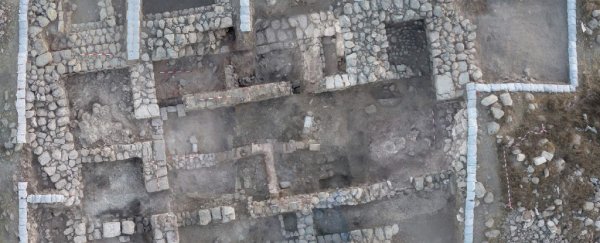Beyond the Biblical legend of David versus Goliath, historical records concerning a far reaching Israelite kingdom in the 10th century BCE have left plenty of room for debate.
A new archaeological study has found evidence supporting the belief that a monarchy just might have united the lands during this important period, while also serving as a reminder of how biases in archaeology can change how we view the past.
Archaeologists Avraham Faust and Yair Sapir from Bar Ilan University in Israel recently published their radiocarbon dating findings on a dig site at Tel 'Eton that pushed the date of the site's establishment to between the 11th and 10th century BCE.
Previous estimates on an elite building known as the governor's residency had it being built centuries later, only to be destroyed by the end of the 8th century by an Assyrian invasion.
Not only does the evidence suggest an Israeli governor was ruling in a Judean town at a crucial period, it serves as a reminder of the challenges archaeologists face in accurately dating ancient sites.
If you were raised on Bible stories, you'd be familiar with the story of how a young shepherd named David defeated a Philistine giant to earn the respect of King Saul and eventually assume rule by uniting the southern land of Judah with his own kingdom of Israel.
On his death this united kingdom was inherited by his son, Solomon, only to fall apart again a generation later.
Outside of traditional recounting of such stories, there's a dearth of solid evidence pinning down the existence and actions of these legendary figures.
Piecing together accounts and circumstantial clues, it's likely that this version of David would have ruled roughly around the 10th century BCE.
But if there was indeed a David-like figure who waged war with the king who took him under his wing, followed by military campaigns that united Israel with Judah, it seems he didn't leave much of a legacy in the form of infrastructure.
At least, that's been the assumption. And without such signs of a complex administration in the Judean lands he's alleged to have conquered, there's little to indicate how he held power over these two rather distinct cultures.
Tel 'Eton sits roughly half way between Gaza and Jerusalem, and represents one of the largest of Judah's archaeological sites.
Its strata show various signs of occupation dating back to the early Bronze Age, some 5,500 to 4,200 years ago.
At some point important administrative structures were built, but by the close of the 8th century the town had been rocked by an Assyrian assault that buried fortifications and an elite four-room residency under a pile of rubble.
The question of when these constructions were first laid down has proven hard to answer.
Given their architecture – a process of interlocking masonry known as ashlar – their establishment would indicate something of the culture that put them there.
It's been taken for granted that the town was flourishing just before the invasion, leading many to assume they appeared during the preceding century.
Thanks to super tidy housekeepers, few clues such as animal bones or pottery have been easily available for radio dating.
Faust and Sapir's team dug deeper, taking samples from the floor and foundations to extract potential organic materials they could test, including charcoal and an olive pit.
By using these items and identifying reasons they could be linked with the building of the foundations, they determined the latest the manor's floor stones could have been laid was 921 BCE, putting its initial construction between the late 11th century and the third quarter of the 10th century BCE.
"This date is in line with other finds related to the construction, like the foundation deposit itself," says Faust.
Significantly, its layout points squarely at an Israelite architect rather than a Judean one, one who didn't so much as destroy the city before building as much as integrate with it.
Just how far this goes to supporting the story of David's uniting of the lands of Israel and Judah is still up for debate.
But the researchers point out their discovery should also serve as a cautionary tale about making assumptions based on limited evidence.
"Archaeologists should therefore be careful when they conclude that the rarity of finds from these eras indicates that society was poor, and lacked social complexity," says Faust.
This research was published in Radiocarbon.
